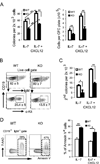Focal adhesion kinase regulates the localization and retention of pro-B cells in bone marrow microenvironments
- PMID: 23264658
- PMCID: PMC3552136
- DOI: 10.4049/jimmunol.1202639
Focal adhesion kinase regulates the localization and retention of pro-B cells in bone marrow microenvironments
Abstract
Progenitor B cells reside in complex bone marrow (BM) microenvironments where they receive signals for growth and maturation. We reported previously that the CXCL12-focal adhesion kinase (FAK)-VLA4 pathway plays an important role in progenitor B cell adhesion and migration. In this study, we have conditionally targeted in B cells FAK, and found that the numbers of progenitor pro-B, pre-B, and immature B cells are reduced by 30-40% in B cell-specific FAK knockout mice. When cultured in methylcellulose with IL-7 ± CXCL12, Fak-deleted pro-B cells yield significantly fewer cells and colonies. Using in situ quantitative imaging cytometry, we establish that in longitudinal femoral BM sections, pro-B cells are preferentially localized in close proximity to the endosteum of the metaphyses and the diaphysis. Fak deletion disrupts the nonrandom distribution of pro-B cells and induces the mobilization of pro-B cells to the periphery in vivo. These effects of Fak deletion on pro-B cell mobilization and localization in BM are amplified under inflammatory stress, that is, after immunization with nitrophenol-conjugated chicken γ-globulin in alum. Collectively, these studies suggest the importance of FAK in regulating pro-B cell homeostasis and maintenance of their spatial distribution in BM niches.
Figures






Similar articles
-
Focal adhesion kinase is required for CXCL12-induced chemotactic and pro-adhesive responses in hematopoietic precursor cells.Leukemia. 2007 Aug;21(8):1723-32. doi: 10.1038/sj.leu.2404769. Epub 2007 Jun 14. Leukemia. 2007. PMID: 17568820
-
Fak depletion in both hematopoietic and nonhematopoietic niche cells leads to hematopoietic stem cell expansion.Exp Hematol. 2012 Apr;40(4):307-17.e3. doi: 10.1016/j.exphem.2011.11.010. Epub 2011 Dec 8. Exp Hematol. 2012. PMID: 22155722 Free PMC article.
-
Retinoic Acid Receptor γ Regulates B and T Lymphopoiesis via Nestin-Expressing Cells in the Bone Marrow and Thymic Microenvironments.J Immunol. 2016 Mar 1;196(5):2132-44. doi: 10.4049/jimmunol.1501246. Epub 2016 Feb 3. J Immunol. 2016. PMID: 26843326
-
Mesenchymal lineage cells and their importance in B lymphocyte niches.Bone. 2019 Feb;119:42-56. doi: 10.1016/j.bone.2017.11.018. Epub 2017 Nov 26. Bone. 2019. PMID: 29183783 Free PMC article. Review.
-
Impaired B lymphopoiesis in old age: a role for inflammatory B cells?Immunol Res. 2013 Dec;57(1-3):361-9. doi: 10.1007/s12026-013-8444-5. Immunol Res. 2013. PMID: 24203438 Free PMC article. Review.
Cited by
-
Cell circuits between B cell progenitors and IL-7+ mesenchymal progenitor cells control B cell development.J Exp Med. 2018 Oct 1;215(10):2586-2599. doi: 10.1084/jem.20180778. Epub 2018 Aug 29. J Exp Med. 2018. PMID: 30158115 Free PMC article.
-
A heteromeric molecular complex regulates the migration of lung alveolar epithelial cells during wound healing.Sci Rep. 2017 May 19;7(1):2155. doi: 10.1038/s41598-017-02204-2. Sci Rep. 2017. PMID: 28526890 Free PMC article.
-
Modeling the Pro-inflammatory Tumor Microenvironment in Acute Lymphoblastic Leukemia Predicts a Breakdown of Hematopoietic-Mesenchymal Communication Networks.Front Physiol. 2016 Aug 19;7:349. doi: 10.3389/fphys.2016.00349. eCollection 2016. Front Physiol. 2016. PMID: 27594840 Free PMC article.
-
Cell circuits and niches controlling B cell development.Immunol Rev. 2019 May;289(1):142-157. doi: 10.1111/imr.12749. Immunol Rev. 2019. PMID: 30977190 Free PMC article. Review.
-
Loss of Ikaros DNA-binding function confers integrin-dependent survival on pre-B cells and progression to acute lymphoblastic leukemia.Nat Immunol. 2014 Mar;15(3):294-304. doi: 10.1038/ni.2821. Epub 2014 Feb 9. Nat Immunol. 2014. PMID: 24509510 Free PMC article.
References
-
- Hardy RR, Hayakawa K. B cell development pathways. Annu Rev Immunol. 2001;19:595–621. - PubMed
-
- Nagasawa T. Microenvironmental niches in the bone marrow required for B-cell development. Nat Rev Immunol. 2006;6:107–116. - PubMed
-
- Visnjic D, Kalajzic Z, Rowe DW, Katavic V, LorenzoH J, Aguila HL. Hematopoiesis is severely altered in mice with an induced osteoblast deficiency. Blood. 2004;103:3258–3264. - PubMed
-
- Osmond DG, Kim N, Manoukian R, Phillips RA, Rico-Vargas SA, Jacobsen K. Dynamics and localization of early B-lymphocyte precursor cells (pro-B cells) in the bone marrow of scid mice. Blood. 1992;79:1695–1703. - PubMed
Publication types
MeSH terms
Substances
Grants and funding
LinkOut - more resources
Full Text Sources
Other Literature Sources
Medical
Molecular Biology Databases
Miscellaneous

